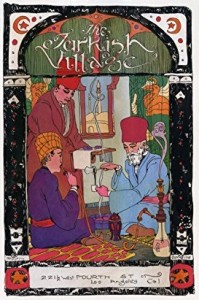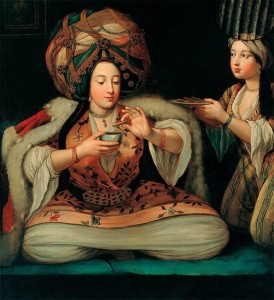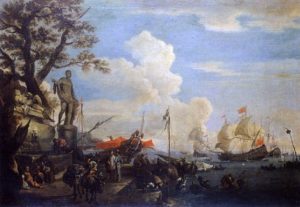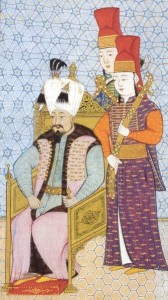Turkish Coffee History - An Important World Asset
 Turkish coffee history begins with an unquestionable fact.
Turkish coffee history begins with an unquestionable fact.
Turkish brewing is the oldest method of coffee preparation.
Turks knew cooking of coffee grounds with water in a special coffee pot since the beginning of the 15th century.
Many important events happened during the pass of history.
Some of them have to do with Turkish coffee history itself.
- They first affected the global way of trading coffee.
- Second, they explain the worldwide expansion of coffee cultivation.
Turkish coffee history - The beginning of an era
The Turkish coffee history starts with the introduction of the coffee beans to Turkey.
There are two different stories about how coffee entered the Turkish culture. Each version seems historically correct.
So, every coffee story teller can pick either of them or why not both of them.
Version A’:
 In 1517 the Ottoman Governor of Yemen Özdemir Paşa (~Ozdemir Pasha~) found out about a new beverage in his region.
In 1517 the Ottoman Governor of Yemen Özdemir Paşa (~Ozdemir Pasha~) found out about a new beverage in his region.
It was a drink from coffee beans.
He decided to introduce it to the Sultan Suleiman the Magnificent.
The new drink impressed the Sultan so much that he gave the Royal seal of approval.
Version B‘:
In 1554 two Syrian men named Hakam from Aleppo & Shams from Damascus moved to Istanbul bringing coffee beans to Turkey.
They opened separate coffee shops in the commercial district of Tahtekale following the idea of Yemen’s shops.
(You can check the legends associated with the introduction of coffee to humanity in my corresponding webpage. I summarize the two most known stories about the invention of coffee).
The first Turkish coffee brew
 After the introduction of coffee beans to Turkey the Sultan’s palace took over.
After the introduction of coffee beans to Turkey the Sultan’s palace took over.
His cuisine staff decided to try a new method in preparing the “black drink”.
They first grounded roasted coffee beans in mortars.
Afterwards they boiled the coffee powder with water in a special coffee pot. This pot is known until today as “cezve” (~jezve~).
A new coffee brew appeared in the Palace scene. It became very popular in the palace premises from the first time.
The elite mansions found about this new drink very soon.
Later, the general public all over the Ottoman Empire got to know it in a matter of time.
Turkish coffee making becomes a profession
 Turkish coffee making soon became a profession.
Turkish coffee making soon became a profession.
A lot of people were opening coffee houses. They were serving this new drink along with other refreshments.
The palace and other high rack governing authorities were employing specialty coffee makers called “kahveci usta”.
They were responsible to prepare coffee to guests like in a ceremonial event.
(You can take a look at my authentic recipe for outstanding tasting Turkish coffee).
During this period, as Turkish coffee history states, coffee was a very valuable commodity among people.
Even a law was giving the right to women to be able divorcing their husbands just for a single reason. They could not provide them with their daily coffee need!
Turkish coffee history and coffee houses
 Turkish coffee history provides a lot of information on the creation and the role of coffee houses.
Turkish coffee history provides a lot of information on the creation and the role of coffee houses.
In 1554 the first coffee houses (“Kaveh kanes”) appeared in Istanbul.
They were the first meeting places to drink coffee.
People who were gathering there were discussing local news or politics. They could also play chess or backgammon.
Turkish coffee history mentions coffee houses many times as very popular places for business meetings.

In 1656 the Ottoman Grand Bizier Köprülü issued laws for shutting the coffee houses.
He decided to make coffee drinking illegal.
According to Turkish coffee history this act was a tremendous shock to the people.
Punishments for disobedience included beating and drowning!
Turkish authorities observed coffee as a threat to the Empire.
According to Turkish coffee history people were gathering in coffee houses and were discussing politics. Some of them were talking about ways to downfall the Sultan as well.
These laws did not succeed. People reacted very negatively with riots.
The authorities abolished these laws after the violent reaction of people.
During those times the Sultan put a heavy taxation on the coffee houses as an extra income to the State.
Turkish coffee travels to Europe
 In 1600 many Turkish merchants started selling coffee beans abroad.
In 1600 many Turkish merchants started selling coffee beans abroad.
First they travel to Venice which was the major trading port of Europe.
Later they introduce coffee to England and slowly to the other European countries.
Coffee history indicates that the name “Turkish coffee” (“Türk kahvesi”) comes from the nationality of the coffee traders.
Today the experts of the Turkish coffee history believe that the name derives mostly from its preparing method.
You can check some other possibilities of the name given to Turkish coffee in my definition webpage.
 In 1657 Sultan Mehmet IV visited France.
In 1657 Sultan Mehmet IV visited France.
Among other presents, he gave to King Louis XIV coffee beans.
This gesture was the initial introduction of the French society to Turkish style coffee.
Turkish coffee history mentions this event as the first step to expand coffee to the rich European countries.
In 1683 during the battle of Austria the Turkish troops left some bags of coffee beans behind.
The Austrians discovered the new beverage. They developed it to a new blend.
- This event is evidence of how important coffee was to even soldiers at war.
By 1850 coffee became as one of the most valuable commodities.
- Many 18th century documents show a lot of merchants trading coffee in Europe like wheat.
(For complete historical highlights on coffee expansion you can visit my corresponding webpage).
Turkish delights accompany Turkish coffee
 Turkish coffee history mentions the use of sugar in the coffee.
Turkish coffee history mentions the use of sugar in the coffee.
Traditionally people were drinking the coffee without any sugar.
Unsweetened coffee had some meaningful names that time; “country style” or “man’s coffee” (even today).
Sugar came to Europe in the 16th century. In Turkey the first appearance of Turkish delight started in 1776 by Bekir Efendi. (Read here about Turkish delight History).
In order to overcome its bitter taste people started offering to their guests for coffee and a small sweet (“Lokum”).
- There is a big remark on Turkish delight making in Turkish culture. Today is a major export commodity that goes together with Turkish coffee.
Turkish delight manufacturing became the first big businesses with close relation to Turkish coffee. (Later coffee pot making and porcelain cups established their trademarks in Turkish coffee business).
This YouTube video will show you how to prepare Turkish delight at home the traditional way, without using gelatin. Nice and funny.
When the tradition of using sugar in beverages became a trend, people started using sugar in Turkish coffee as well.
- Nowadays, you make Turkish coffee after asking the guests how much sugar they prefer in their coffee.
![]() - - RECOMMENDED ARTICLES - -
- - RECOMMENDED ARTICLES - -
 |
 |
 |
|||||
 |
 |
 |
|||||